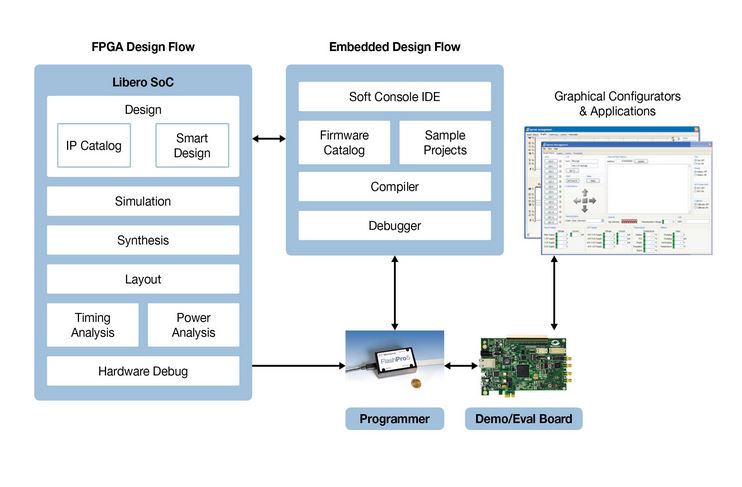By Brian Santo, contributing writer
Microsemi Corp. has created lower-power versions of its PolarFire field-programmable gate arrays (FPGAs) and simultaneously released an updated version of its design suite that supports the new products. The Libero system-on-chip (SoC) PolarFire Design Suite v2.2, which gives designers access to the new “L” series PolarFire FPGAs, includes a smart debug tool.
Microsemi, recently acquired by Microchip, specializes in smaller, lower-power FPGAs compared to other FPGA makers, notably Intel’s Altera and Xilinx. Every FPGA in Microsemi’s new L series is characterized by even lower static power, in some cases by as much as 30% to 35% lower than the standard PolarFire version.
That can help in a couple of different ways. Lower-power FPGAs can be smaller and lighter, which is helpful to designers looking to shrink the size of their products, particularly portable devices. In battery-powered devices, a lower-power processor enables designers to either reduce the size of the product’s battery or deliver longer battery life.
Tim Morin, director of product marketing for Microsemi’s programmable solutions business unit, told Electronic Products that Microsemi tested one of its major competitor’s FPGAs against an L series PolarFire and found that the former drew 17 W while the latter drew only 7 W.
“That’s a needle mover,” said Morin. That could be the difference between having to use a fan for cooling or not, keeping in mind that fans are notorious for eventually failing, he added.

Microsemi said that the L series PolarFire chips are especially suited for low-power portable defense and professional-grade consumer systems.
Applications might include night-vision goggles or night scopes, said Morin. Both are battery-powered and neither rely on high-resolution imagery, so an IC with both low static power and modest processing power — an L series PolarFire, for example — is appropriate.
Some mobile military communications systems have needs that are similar. Not much data is being transmitted, but what is exchanged needs to be encrypted. The application doesn’t represent enough volume for anyone to build a standard part, so a low-power FPGA programmed to do encryption is a very good solution, continued Morin.
The company said that the upgraded design suite enables faster design completion, with a 15% improvement in runtime for place and route together with a 2.5x runtime improvement for programming file generation.
Morin said that one of the “grooviest” features of the suite was the debug tool, which designers can use to look at any two flip-flops at any time. “If I have an FPGA with 300,000 flip-flops and my design’s not working, how do I figure out what’s wrong? Smart Debug allows me to observe any two flip-flops in a design in real time at any time. Effectively, what I’m doing is moving a probe — imagine a two-channel oscilloscope or logic analyzer — inside the chip, where the data shows up on two pins. The key thing is that I don’t have to re-place and re-route or re-program the chip. It provides quick visibility into the problem.”
Microsemi’s Libero SoC PolarFire v2.2 software toolset is now available for download from Microsemi’s website. The company said that PolarFire FPGA MPF300XT devices are available for purchase in full production, while the MPF300T/TS and MPF200T/TS devices are available in pre-production. There is a full list of L series on the company’s website; Morin said that there’s an L series version of every PolarFire FPGA.
Advertisement
Learn more about Electronic Products Magazine





